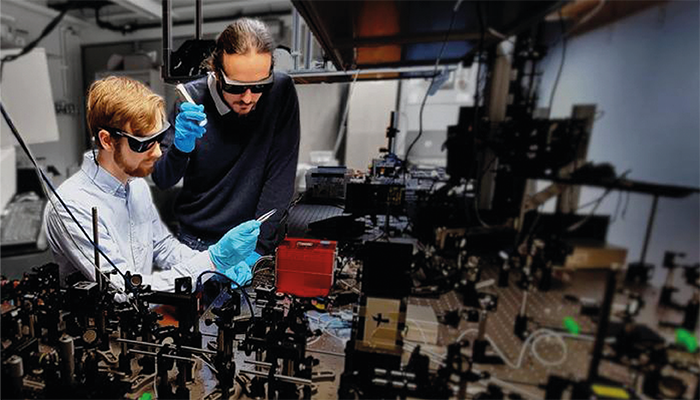
Researchers at Aalto University hold a tiny chip, designed to accommodate hundreds of ultra-compact spectral sensors.
Credit: Faisal Ahmed and Andreas Liapis / Aalto University
Researchers at Aalto University, Finland, have developed a microscopic spectral sensor capable of high-precision chemical analysis, offering a compact alternative to conventional laboratory-based spectrometers. Measuring just 5 micrometers across, the device leverages an electrically tunable optoelectronic interface to analyze light-matter interactions, achieving spectral resolution comparable to larger, more complex systems. Its small size and versatility open opportunities for real-time spectral analysis in applications ranging from environmental monitoring to biomedical diagnostics and consumer electronics.
The sensor’s core consists of a niobium ditelluride (NbTe₂) electrode and an indium selenide (InSe) semiconductor, forming an electrically tunable van der Waals heterostructure. This configuration allows precise control of the sensor's response to light through bias and gate voltage adjustments.
“Our device is ‘trained’ to recognize complex light signatures that are imperceptible to the human eye, achieving a level of precision comparable to the bulky sensors typically found in laboratories,” said lead researcher Zhipei Sun in a press release.
The device achieves spectral identification with a resolution of approximately 0.19 nanometers in free space and 2.45 nanometers when integrated onto a chip. Unlike conventional spectrometers that rely on optical components such as prisms or gratings, this sensor performs spectral differentiation via its electrical response to light – opening the door to integration into portable devices, such as smartphones and wearables.
To validate the sensor’s performance, the researchers conducted a series of experiments using monochromatic and broadband light sources. The device was "trained" to generate unique electrical fingerprints for different light interactions, allowing it to identify organic dyes, metals, semiconductors, and dielectrics with minimal error.
“Our innovative spectral sensing approach simplifies challenges in material identification and composition analysis,” said Xiaoqi Cui, the study’s lead author.
One of the key advancements of the sensor is its ability to overcome rank deficiency issues commonly found in miniaturized spectrometers. Previous designs often suffered from limited spectral resolution due to uncorrelated photoresponse matrices. The tunable optoelectronic interface introduced in this study enhances the flexibility and precision of spectral analysis by enabling multi-dimensional photoresponses, ensuring improved accuracy in compound differentiation.
The researchers also tested the integration of their device with silicon nitride (Si₃N₄) waveguides, demonstrating its potential for on-chip applications. The system’s on-chip implementation maintained high spectral resolution and offered compatibility with photonic integrated circuits, making it suitable for applications such as lab-on-chip devices and optical computing.
Looking ahead, future research will focus on optimizing the device's signal-to-noise ratio and expanding its spectral range to detect a broader range of chemical compounds.




